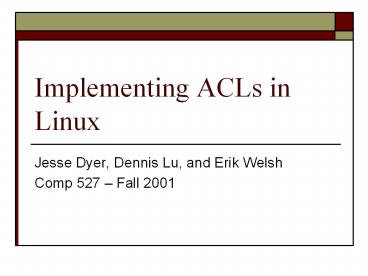Implementing ACLs in Linux PowerPoint PPT Presentation
Title: Implementing ACLs in Linux
1
Implementing ACLs in Linux
- Jesse Dyer, Dennis Lu, and Erik Welsh
- Comp 527 Fall 2001
2
Overview
- Why ACLs?
- Solaris ACLs
- NT ACLs
- Our ACLs
- VFS
- Our Implementation
- Some Examples
- Problems and Future Work
3
In case you were sleeping
- What is an ACL?
- Access Control List collection of Access Control
Entries (ACEs) associated with a file. - What is an ACE?
- A structure specifying permission for a user,
group, or other entity. - What is an inode?
- A structure containing metadata about files and
directories.
4
Why ACLs?
- Traditional rwx for ugo not fine grained enough
- File owner controls all permissions
- Can allow group, but admin controls groups,
creates administrative headache - Want to give specific user or group ability to
access to files and directories
5
For Example CVS on owlnet
- Must give world rwx permissions!
- Allows ANY malicious user or accident to mess up
your project files - Preferably give access to certain directories to
certain people
6
Solaris ACLs
- Standard ACL implementation
- Can give specific and multiple users and groups
rwx permission on a file - Has mask entry
- Almost POSIX compliant
7
NT ACLs
- Even more fine grained than Solaris
- Adds ability to let someone delete, modify the
permissions of, or take ownership of a file - Has ability to inherit permissions
- Adds ability to deny access to a file
- Order to apply rules
- Has Everyone user
8
Our ACLs
- Combination of Solaris and NT ACLs
- Have traditional rwx for multiple users and
groups - Added p (permission)
- Added inheritance
- Added ability to deny
- Rules applies in order
9
VFS
- Acts as layer of abstraction between different
filesystems and file access programs - All fs calls go through VFS at some point
- Provides common interface for several fs
- Different fs must register with the VFS
- Different fs operations called by using function
pointers
10
ext2
- Default Linux file system
- Allows for variable size blocks to minimize
fragmentation - Variable number of inodes to maximize usable
space - Block preallocation for files to reduce
fragmentation - Disk blocks partitioned into groups
- Robust crash recovery
- Designed to be extensible (ACLs, encryption, etc)
11
Our Implementation
- Modified version of ext2 on Mandrake
- Kept ACL information in the inode, not in blocks
- Max users 32
- Compiled as kernel module
- Modified mke2fs to setup our fs and ext2fsck to
not demolish our ACLs
12
Permission Checking
- If no ACL present, reverts to traditional file
permissions - Search for any deny, then allow
- Support for new modify permission functionality
13
setfacl
- User command utility to set, modify, or delete
ACLs on a file - Can be ran by file owner or anyone given
permission to modify permissions - Sample commands
- setfacl s ualicerxi myFile
- setfacl m odrwx myFile
- setfacl u myFile
- setfacl d ualice myFile
14
getfacl
- User utility to examine the ACL on a particular
file - Examines a files inode to detemine what
permissions are set - Sample
- getfacl myFile
15
Example
- touch samplefile
- getfacl samplefile
- no ACL set
- setfacl s uwelshrw samplefile
- getfacl samplefile
- file samplefile
- owner dlu
- group brown
- Inherits from parent
- userrw-pi
- userwelshrw-- i
- groupr---i
- otherr---i
16
Example
- setfacl m uwelshdxp samplefile
- getacl samplefile
- file samplefile
- owner dlu
- group brown
- userrw-pi
- userwelshrwltxgtltpgti
- groupr---i
- otherr---i
17
Example permission partitions
Development
Marketing
QA
18
Problems
- Open Source code is inconsistently documented
- Communication between kernel and user programs is
confusing - Testing is a pain
19
Future Work
- Make it as a patch to the current linux
distribution - Determine the optimum number of ACLs to be kept
- Caching effective ACLs minimizes performance hit
from inheritance - Graphical User Interface
20
The Ideal ACL
- Deny and allow have equal importance, based on
their location in the ACL. I.e. Order matters. - Example
- User Chuck member of everyone, losers.
- ACL allow Chuck deny losers allow everyone ?
Chuck is given access. - Existing implementation ? Chuck is denied access
21
References
- Bovet and Cesati, Understanding the Linux Kernel,
OReilly, 2001 - Anderson, Security Engineering, Wiley, 2001
- Linux Documentation Project
- Algis
- Dan

